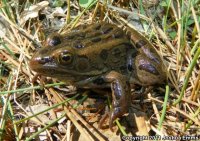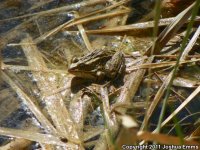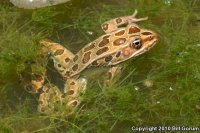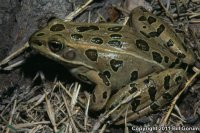| Range: |
 |
| Other Names: |
|
| Description: |
The Northern Leopard Frog is a smooth-skinned green, brown, or sometimes yellow-green frog with well-defined dark spots. One large dark spot is typically present on the snout. The pattern on the rear of the thigh is also diagnostic, and includes a few dark spots or blotches on a light background. A big northern leopard frog is about 4.5 inches in length. Tadpoles reach 3.25 inches total length. |
| Similar Species: |
It can be distinguished from the Plains Leopard Frog by its continuous dorsolateral folds that are not broken posteriorly and inset medially, (a character that separates L. pipiens from all other leopard frogs in New Mexico), the absence of spots on the tympanum and a thigh pattern of discrete dark spots on a light ground color. Tadpoles are similar to the Plains Leopard Frog, but less pale, and with dark spots and patches on the tail. |
| Habitat: |
The Northern Leopard Frog inhabits mostly ponds, cattle tanks, and lakes, but is also found in streams and rivers from 3,120 to 9,150 feet elevation. |
| Behavior: |
Can be found active day or night when water temperatures are roughly >54 degrees F. May be active in wet meadows away from water during summer. |
| Hibernation: |
|
| Reproduction: |
Breeding probably occurs from April-July (late summer breeding has been documented in New Mexico). Most tadpoles likely metamorphose in 3-6 months before the fall cool down, but some tadpoles overwinter. The advertisement call is a medley of chuckles, snores, and grunts. |
| Diet: |
Northern Leopard Frogs eat a variety of aquatic and terrestrial invertebrates. Larger frogs eat small leopard frogs, other amphibians, fish, snakes, and other vertebrates, as well. |
Adapted from account on reptilesofaz.org
Sources:
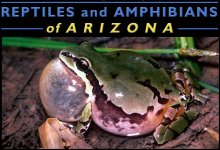

|


